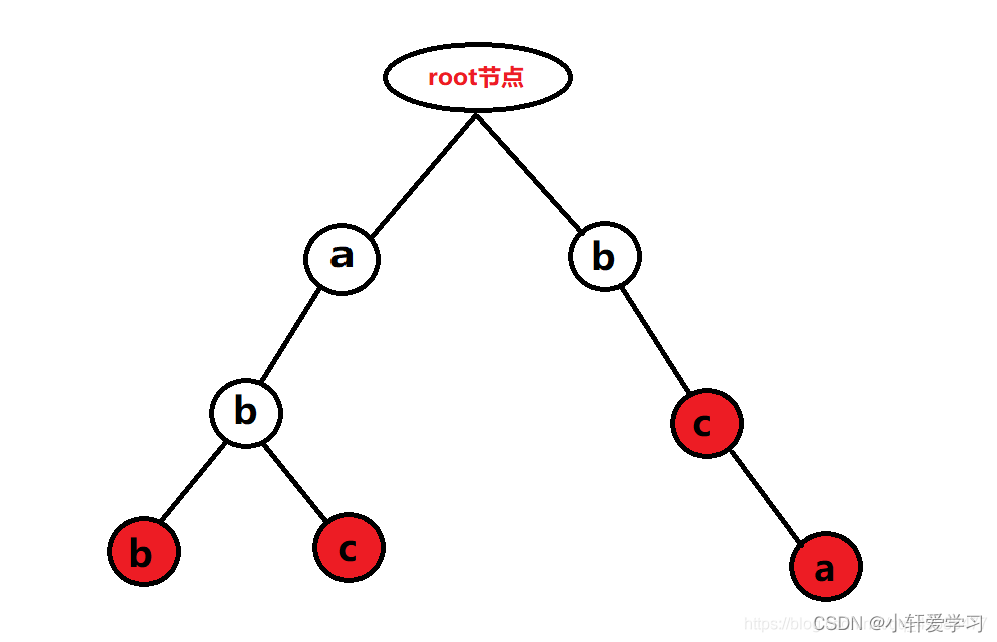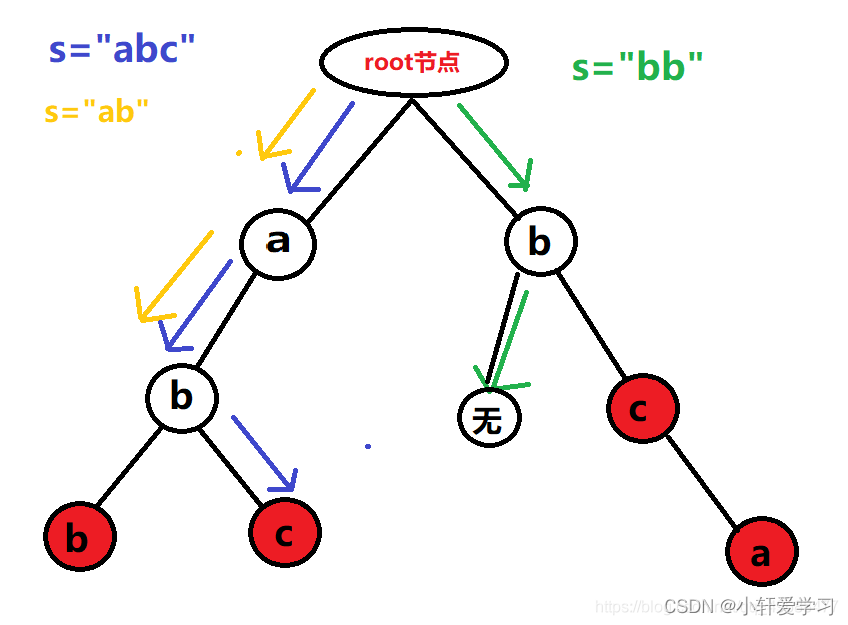字典树/前缀树
Trie(发音类似 “try”)或者说 前缀树(字典树) 是一种树形数据结构,用于高效地存储和检索字符串数据集中的键。这一数据结构有相当多的应用情景,例如自动补完和拼写检查。主要思想是利用字符串的公共前缀来节约存储空间。很好地利用了串的公共前缀,节约了存储空间。字典树主要包含两种操作,插入和查找。
比如,我们要怎么用树存下单词"abc",“abb”,“bca”,"bc"呢?见图
 在图中,红点代表有一个以此节点为终点的单词。然后,我们如果要查找某个单词如s=“abc”,就可以这样
在图中,红点代表有一个以此节点为终点的单词。然后,我们如果要查找某个单词如s=“abc”,就可以这样

在这里,s=“abc” 的每一个字母都在树中被查到了,并且最后一个点是红色代表有一个在此结束的单词,查询成功。而 s=“bb” 的第二个字母没有在相应位置被查到,因此"bb"不在字典中。至于s=“ab” 虽然单词中每个点都被查到了,但是由于结尾的字母在树中没有标红,因此也是不在字典中。
对于字典树的每次查找,时间复杂度为log级别,比暴力快多了。
例题
字典树有多中实现方法,可以通过数组存储,也可以通过哈希表来存储,本文我们主要讲解这两中方法:
力扣208题:实现 Trie (前缀树)
请你实现 Trie 类:
- Trie() 初始化前缀树对象。
- void insert(String word) 向前缀树中插入字符串 word 。
- boolean search(String word) 如果字符串 word 在前缀树中,返回 true(即,在检索之前已经插入);否则,返回 false 。
- boolean startsWith(String prefix) 如果之前已经插入的字符串 word 的前缀之一为 prefix ,返回 true ;否则,返回 false 。
示例:
输入 [“Trie”, “insert”, “search”, “search”, “startsWith”, “insert”,“search”]
[[], [“apple”], [“apple”], [“app”], [“app”], [“app”],[“app”]]
输出 [null, null, true, false, true, null, true]
解释:
Trie trie = new Trie();
trie.insert(“apple”);
trie.search(“apple”); // 返回 True
trie.search(“app”); // 返回 False
trie.startsWith(“app”); // 返回 True
trie.insert(“app”);
trie.search(“app”); // 返回 True
提示:
1 <= word.length, prefix.length <= 2000
word 和 prefix 仅由小写英文字母组成
insert、search 和 startsWith 调用次数 总计 不超过 3 * 104 次
实现(Java)
class Trie {
private Trie[] children; // 存放子结点,当不为null时,即当前位置被激活
private boolean isEnd; // 判断此位置是否是单词的结尾
public Trie() {
children = new Trie[26];
}
public void insert(String word) {
Trie node = this;
for(int i = 0; i < word.length(); i++) {
char ch = word.charAt(i);
int index = ch - 'a';
if(node.children[index] == null) {
node.children[index] = new Trie();
}
node = node.children[index];
}
node.isEnd = true;
}
public boolean search(String word) {
Trie node = this;
for(int i = 0; i < word.length(); i++) {
char ch = word.charAt(i);
int index = ch - 'a';
if(node.children[index] == null) {
return false;
}
node = node.children[index];
}
return node != null && node.isEnd == true;
}
public boolean startsWith(String prefix) {
Trie node = this;
for(int i = 0; i < prefix.length(); i++) {
char ch = prefix.charAt(i);
int index = ch - 'a';
if(node.children[index] == null) {
return false;
}
node = node.children[index];
}
return true;
}
}
/**
* Your Trie object will be instantiated and called as such:
* Trie obj = new Trie();
* obj.insert(word);
* boolean param_2 = obj.search(word);
* boolean param_3 = obj.startsWith(prefix);
*/
力扣648题:单词替换
在英语中,我们有一个叫做 词根(root) 的概念,可以词根后面添加其他一些词组成另一个较长的单词——我们称这个词为 继承词(successor)。例如,词根an,跟随着单词 other(其他),可以形成新的单词 another(另一个)。
现在,给定一个由许多词根组成的词典 dictionary 和一个用空格分隔单词形成的句子 sentence。你需要将句子中的所有继承词用词根替换掉。如果继承词有许多可以形成它的词根,则用最短的词根替换它。
你需要输出替换之后的句子。
示例 1:
输入:dictionary = [“cat”,“bat”,“rat”], sentence = “the cattle was rattled by the battery”
输出:“the cat was rat by the bat”
示例 2:
输入:dictionary = [“a”,“b”,“c”], sentence = “aadsfasf absbs bbab cadsfafs”
输出:“a a b c”
提示:
- 1 <= dictionary.length <= 1000
- 1 <= dictionary[i].length <= 100
- dictionary[i] 仅由小写字母组成。
- 1 <= sentence.length <= 10^6
- sentence 仅由小写字母和空格组成。
- sentence 中单词的总量在范围 [1, 1000] 内。
- sentence 中每个单词的长度在范围 [1, 1000] 内。
- sentence 中单词之间由一个空格隔开。
- sentence 没有前导或尾随空格。
实现(Java)
class Solution {
public String replaceWords(List<String> dictionary, String sentence) {
Trie trie = new Trie();
for(String word : dictionary) {
Trie cur = trie;
for(int i = 0; i < word.length(); i++) {
char ch = word.charAt(i);
cur.children.putIfAbsent(ch, new Trie());
cur = cur.children.get(ch);
}
cur.children.put('#', new Trie());
}
String[] words = sentence.split(" ");
for(int i = 0; i < words.length; i++) {
words[i] = find(words[i], trie);
}
return String.join(" ", words);
}
public String find(String word, Trie trie) {
for(int i = 0; i < word.length(); i++) {
if(trie.children.containsKey('#'))
return word.substring(0, i);
Character ch = word.charAt(i);
if(!trie.children.containsKey(ch)) {
return word;
}
trie = trie.children.get(ch);
}
return word;
}
}
class Trie {
// 哈希表存放<字符, 下一个字符>,注意当下一个字符有'#'时表示该字符为单词结尾
Map<Character, Trie> children;
public Trie() {
children = new HashMap<Character, Trie>();
}
}
前缀树就先总结到这里,之后遇到其他方法还会继续更新哦,谢谢大家的点赞支持!

























 1502
1502











 被折叠的 条评论
为什么被折叠?
被折叠的 条评论
为什么被折叠?








